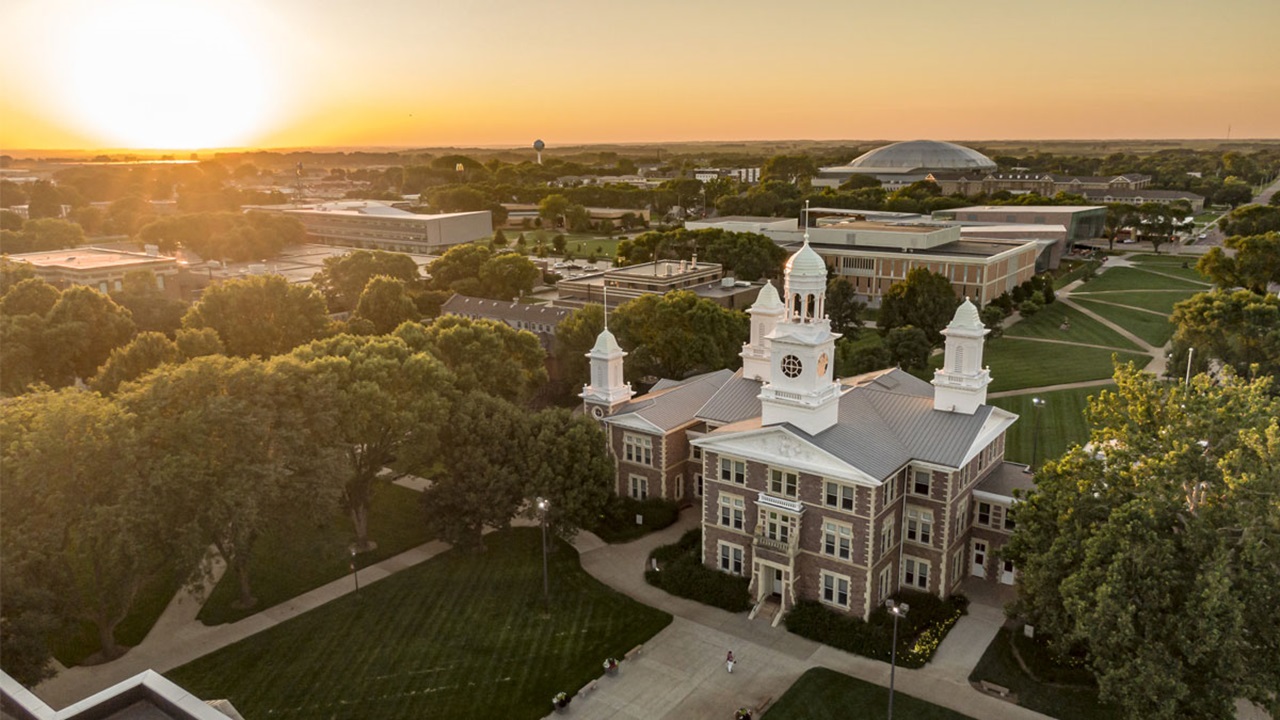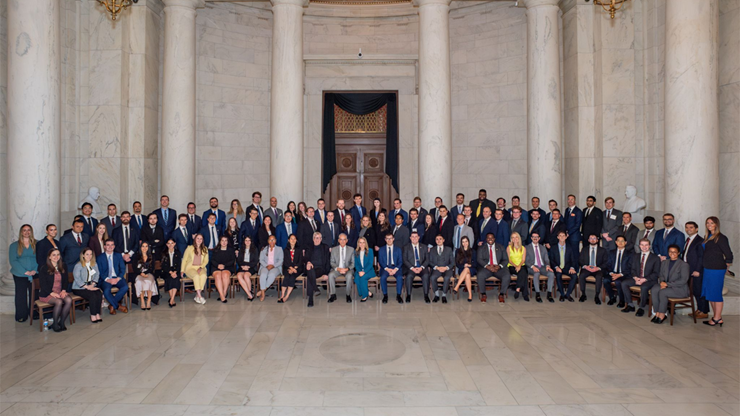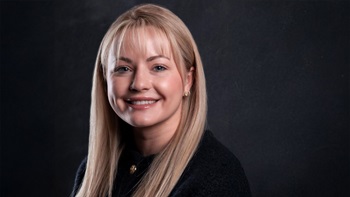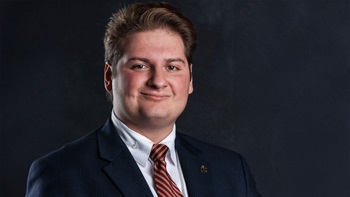Alumnus O'Connor Argues at U.S. Supreme Court

Increasingly, these law enforcement officers are accompanied by canine (K-9) units that sniff around the outside of the stopped vehicle, alerting officers to criminal activity and prompting a search of the vehicle.
In 2012, on a lonely stretch of highway in Nebraska, a traffic stop concluded and was followed with a canine search, revealing methamphetamine in the vehicle. Little did the driver know that years later the events surrounding the traffic stop would be argued in front of the Supreme Court of the United States. The attorney representing the driver? One of University of South Dakota School of Law’s own graduates, Shannon O’Connor ’80.
After representing approximately 2,000 felony clients and trying more than 100 jury trials, including appellate cases before the Nebraska Court of Appeals, Nebraska Supreme Court and Eighth Circuit Court of Appeals, Shannon O’Connor was ready to retire. He dreamt of warm days spent on any of Omaha’s golf greens and spending time with his children and grandchildren. Just days before he was to pack up his office at the Federal Public Defender’s Office for the District of Nebraska, he received news that the United States Supreme Court granted certiorari and wanted to hear oral arguments on his case. As this was an honor of a lifetime—the Supreme Court only called 80 cases in 2015 for oral argument, out of the thousands of cases appealed—he decided to postpone retirement until after oral arguments.
O’Connor’s case, Rodriguez v. United States, 135 S. Ct. 1609 (2015), started off with a simple traffic stop near Omaha. On March 27, 2012, a K-9 officer stopped Dennys (“Dennis”) Rodriguez for driving on a highway shoulder. After the officer attended to everything relating to the stop (i.e., checking the driver’s licenses of Rodriguez and his passenger and issuing a warning for the traffic offense), he asked Rodriguez for permission to walk his dog around the vehicle. When Rodriguez refused, the officer detained him for eight minutes until a second officer arrived and they could secure the passengers while performing a K-9 search of the car. The dog alerted to the presence of drugs in the vehicle. The officer discovered methamphetamine during a search and promptly arrested Rodriguez.
Rodriguez was assigned O’Connor as a federal public defender. The first course of action O’Connor took was to immediately file motions to suppress the evidence based on Constitutional search and seizure issues. The district court judge denied the motion. O’Connor then made an appeal to the United States Court of Appeals for the Eighth Circuit. The Court of Appeals denied the appeal.
“Dennys didn’t trust me,” said O’Connor. “He said, ‘You are just like the rest of them, you just want to railroad me.’ After we appealed to the 8th Circuit, he actually tried to have me fired and taken off the case. I told Dennys that I still have fire in my belly for this case. Let’s just go straight to the Supreme Court.”
On Jan. 21, 2015, O’Connor argued the case in front of the Supreme Court. He officially retired on Jan. 23, not receiving the opinion of the Court until April 21. Justice Ruth Bader Ginsburg wrote the opinion of the Court, in favor of Rodriguez. The Court held that officers may not detain motorists after the completion of a traffic stop simply to run a canine drug sniff search based solely on a hunch of criminal drug activity. O’Connor had won his first Supreme Court case, and the last case of his career.
“Appearing before the United States Supreme Court is a surreal experience. The whole place is small; much smaller than a person would think,” O’Connor recalled. “The bench, where the justices sit, is ornate and concave. And the podium where you argue is 10 feet from the chief justice. Plus, the justices are inquisitive: Ginsburg, Alito, Scalia and Roberts all interrupted me to ask questions before I even made it through my two-minute introduction. Justice Thomas had made up his mind before he even woke up that day. He didn’t even make eye contact.
“The satisfaction I get with the Rodriguez case is not that we won at the Supreme Court—it is that I worked with my client and made the right moves in the lower courts, and got everything into the record that I wanted.”
“I still had a fire in my belly for this case. I said, 'Let’s just go straight to the Supreme Court.'”
—Shannon O'Connor
Originally from a small farm and one of 11 children, O’Connor attended high school in Vermillion, South Dakota. He would go on to receive a Bachelor of Science degree in political science from the University of South Dakota (1977) and become involved in the greater Vermillion community. Being in political science, he was inducted as a member of the “Farber Boys,” a group of students that would regularly meet with William “Doc” Farber at his home across from Slagle Hall in Vermillion. From there, he matriculated directly into the University of South Dakota School of Law.
“My daughter was born the middle of the first semester of my first year at the USD School of Law,” he said. “I didn’t have opportunities for study groups as everyone seemed do their work on their own or had cliques. With my newborn daughter, my schedule kept me at home most of the time. I do remember taking Chuck Thatcher’s Secured Transactions or Uniform Commercial Code class, and he would always have time to talk to me when I was struggling in my studies.”
O’Connor’s mother thought her son needed extra encouragement during his tenure at the law school. She mailed him a framed picture of a lion, hanging from a branch by its magnificently massive paws, crying for help. The caption read, “Hang in there.” These words would be the mantra for a distinguished USD School of Law graduate as he navigated a lifelong path that would eventually lead him to the United States Supreme Court footsteps.
That path would include many different careers, mainly rooted in criminal law. After leaving USD School of Law, O’Connor spent four years in the United States JAG Corps at Fort Riley, Kansas. This was followed by a brief stint in private practice at a family law practice.
“I learned quickly that family law was not for me: it’s too personal,” O’Connor explained. “It was emotionally taxing and generally devastating.”
O’Connor and his family relocated to Omaha. There he would spend seven years in the Douglas County Public Defender’s Office.
“The Eighth Circuit created a new program, the Federal Public Defender’s Office for the District of Nebraska, and I wanted in. Luckily, I was one of the first guys hired in the office. I spent the next 20 years as a federal public defender.”
O’Connor was chosen to be the honored speaker for the Hooding Ceremony of the University of South Dakota School of Law Class of 2018 on May 4, 2018.
His advice to current students?
“Stick with it,” he said. “Don’t be discouraged. Even if your grades are not great (look at mine, for example), you can go anywhere from the law school. If you are unsure of what you want to do after you graduate, just heed the words of the ‘80s cat-eating philosopher Alf: ‘Find out what you don’t do well, then don’t do it.’”




